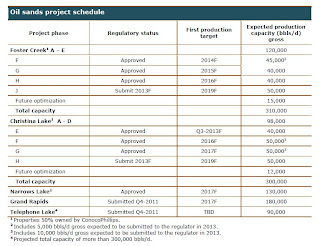 |
| Bitumen seep at Primrose. Picture stolen from the Edmonton Journal. |
Since at least May, CNRL's Primrose Cyclic Steam Stimulation (CSS, or "Huff and Puff") project has been leaking bitumen to the surface near Cold Lake and Bonnyville. In total an estimated 6,600 barrels have leaked. The company has stopped steaming that part of the reservoir (under orders from the Alberta Energy Regulator, or AER) and the leak rate is now reportedly under 20 barrels per day and declining daily. It could continue leaking (at lower and lower rates) for months or even years. At the moment Primrose is CNRL's only producing in-situ oil sands project, although a number of others are in various stages of development.












